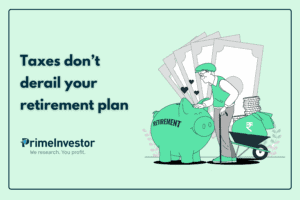With inputs from Bipin Ramachandran.
The NPS Scheme (National Pension System Scheme) is a market-linked, Central Government scheme, designed to help you systematically provide for your retirement. The scheme was launched in December 2003.
While the NPS scheme was mandatory for Central Government employees from way back in January 2004, it was then made available to all Indian citizens on a voluntary basis (including NRIs and OCIs) between 18 and 70 years. It is also available on a voluntary basis to corporates for their employees.
But this is just one of the many ways in which the NPS scheme has transformed over the years.
From allowing greater allocation to equity, increasing maximum entry age to 70 years, facilitating more flexibility to subscribers to fetching several tax benefits, the NPS scheme has evolved into a powerful avenue to invest towards building your wealth for retirement.
We think that the scheme in its current avatar is a serious contender for a share of your retirement portfolio, and here are the top 5 reasons why.

# 1 Separate fund managers for each asset class
Prior to December 2023, investors who opted for the ‘active choice’, (as against ‘auto choice’ where the asset allocation will be taken care of for you) with respect to asset allocation, were only able to choose one fund manager to manage all of their asset classes – Equity, Corporate Bonds, Government Securities and Alternative Assets. While the active choice means that an investor comfortable with taking charge of asset allocation for her pension investments was able to do so, she had to work with only one fund manager.
That changed in November 2023.The NPS allows you to select up to 3 fund managers in accordance with the asset classes with the exception of Alternative Assets. That is, you can choose different fund managers for different asset classes.
This flexibility is a great advantage. Each asset class requires a different investment strategy. Going by the performance of pension fund managers (PFM), some are more adept at one asset class over another. The earlier rule on a single PFM meant that you may wind up compromising on returns in one asset class.
With this change, you can effectively choose the best fund manager under each asset class, giving you greater control over how your investments under the NPS scheme performs.
This facility is available to subscribers to Tier I under the all citizens model and the corporate model as well as all subscribers to Tier II who opt for the ‘active choice’.
You get to exercise the fund manager choice once every financial year – that’s more than enough to make sure your NPS is delivering up to mark! We have accordingly also changed our NPS Fund Manager Ranking tool, which scores PFMs based on various performance metrics including consistency, downsides, and returns. Earlier, we had considered your NPS asset allocation along with PFM performance metrics to give you the PFM ranking list that best fit your requirement. We have now modified the methodology to give you separate PFM rankings for each asset class, and you can choose the PFM that’s best at managing it.
# 2 Rebalancing flexibility
The second benefit is that you can switch between asset classes – without incurring taxes. The NPS allows you to change your asset allocation up to 4 times in a financial year, which effectively translates into rebalancing your asset allocations. How?
Well, remember that the allocation you set is the proportion in which your contribution is deployed. Like with your mutual fund portfolio, market movements will change the allocation of the total NPS investment. When you change the NPS contribution allocation, two things happen – one, your fresh contribution will be in the new allocation and two, your existing investment will be altered to reflect this new allocation. You can use this to effectively rebalance your portfolio, without capital gains taxes.
For example, let’s say you had a 40% Equity, 40% Govt debt and 20% Corporate debt in your NPS allocation. Owing to market movements, the actual allocation grew to 45% Equity, 35% Govt debt and 20% Corporate debt. You can use the option to set asset allocation to trigger a rebalancing here by making a nominal change in your NPS allocation. You can, say, set it to 39% Equity, 41% Govt debt and 20% Corporate debt which will see profits booked in equity (which has run up) and reinvested in Govt debt (which has been comparatively lower).
#3 Systematic lump sum withdrawal (SLW) feature
This is another aspect where recent changes have made the NPS more attractive. Under the NPS scheme, a ‘normal withdrawal’ happens when the subscriber completes 60 years / superannuation.
Up until now, the rule was that you can withdraw a maximum of 60% of the corpus as a lump sum and use a minimum of 40% of the corpus to buy an annuity plan. The subscriber also has the option to continue in the NPS till the age of 75. While exiting, the subscriber can defer receiving the lump sum till 75 or receive it in annual instalments till the age of 75. If the annual withdrawal route has been opted for, each time, the subscriber has to initiate the withdrawal request.
This changed with the introduction of the systematic lump sum withdrawal (SLW) in October 2023.
With this feature, the subscribers are allowed to withdraw up to 60% of their pension corpus on a periodical basis i.e. monthly, quarterly, half-yearly or annually. Such periodic withdrawal can be done until they hit 75 years of age. This is an attractive option and an extremely useful one for several reasons.
- One, it saves the bother of planning on how to invest the lump sum received in a manner that would generate a monthly income as well as balance return and safety – this is a tricky process for most investors, and the amount involved can be fairly large. Given that asset allocation within the NPS can be changed, it is possible to allocate a higher share to debt post 60.
- Two, it makes the withdrawal process far easier since it does away with the need to initiate a withdrawal each time, and the increased frequency makes it more useful for building a steady income flow post-retirement.
- Three, if we were to extend the tax treatment of lump sum withdrawals to withdrawals via the SLW route, these payouts would be tax free up to 60% of the corpus. However, if the subscriber were to take the whole 60% withdrawal in one go, invest the same in mutual funds and opt for an SWP to meet his periodic financial requirements, capital gains on these payouts would be subject to tax.
The SLW facility is only available for Tier I accounts. Once the SLW starts, fresh investments are not permitted.
# 4 Multiple annuities
Earlier, the minimum 40% that had to be used to purchase an annuity in a normal withdrawal could only be used to purchase a single annuity from one of the annuity service providers enrolled under NPS.
Via a circular in May 2023, the PFRDA opened this up to allow subscribers to purchase multiple annuities from the same annuity service provider. This option is provided to subscribers who have earmarked the annuity portion of the corpus at a minimum of Rs 10 lakhs with Rs 5 lakhs to be used for each annuity.
At present, there are five types of annuities that a subscriber can choose from. Each one operates differently and caters to a different need. For instance, the annuity for life makes a consistent payout through the lifetime of the subscriber and terminates on the death of the subscriber. Whereas, in the annuity for life with return of purchase price, it pays an annuity during the lifetime of the subscriber and then after, pays the purchase price to the nominee. The annuity with return of purchase price typically comes with lower yields as compared to the one without a return of purchase price.
This feature of allowing you to invest in multiple annuity plans means that you don’t have to choose between one or the other. Depending on your need for income versus leaving a legacy, you can decide on how much to allocate to each type of annuity.
# 5 Tax benefits for the NPS Scheme
The favourable tax treatment is indeed attractive. Here is a quick recap of the tax benefits that the scheme brings.
At the time of contribution
As an employee contributing to NPS, you will be eligible for the following benefits, provided you opt for the old regime:
- Tax deduction up to 10% of salary (Basic + DA) under section 80 CCD(1) within the overall ceiling of Rs. 1.50 lakh.
- Tax deduction up to ₹50,000 under section 80 CCD(1B) over and above the overall ceiling of Rs. 1.50 lakh.
As an employee, you are eligible for the following benefits on what your employer contributed:
- Tax deduction up to 10% of salary (Basic + DA) (14% if such contribution is made by Central Government) contributed by employer under Section 80 CCD(2) over the limit of Rs. 1.50 lakh provided under section 80 CCE. Budget 2024 increased this limit from 10% to 14% even for non-Government employees.
- This benefit is available even if you opt for the new tax regime but is capped at Rs. 7.5 lakhs including employer’s contribution toward EPF and superannuation.
If you are self-employed and have an NPS account, you are eligible for (provided you opt for the old tax regime):
- Tax deduction up to 20 % of gross income under section 80 CCD (1) subject to the overall cap of Rs. 1.50 lakh under Sec 80 CCE.
- Tax deduction up to ₹50,000 under section 80 CCD(1B) over and above the overall ceiling of Rs. 1.50 lakh under Sec 80 CCE.
At the time of withdrawal
Under normal withdrawal when you purchase your annuity, you are eligible for tax exemption on purchase of annuity under section 80CCD(5). However, the periodic payments that you receive going forward are taxable.
The lump sum (up to 60%) under normal withdrawal too is tax free under section 10(12A).
Granted, most of the tax advantages explained above are restricted to those in the old tax regime. Even so, the NPS remains a good option for those in the new tax regime as well. For one, the tax exemption of 60% of the corpus (which applies in both old and new tax regimes) at the time of withdrawal compares favourably with mutual funds. Two, it is possible to rebalance allocations in a tax-free manner in the NPS as explained above.
Three, in debt allocations especially, the NPS makes a strong case – the NPS’ ultra-low expenses compared to debt mutual funds aid higher returns to begin with. Added to this is that debt mutual funds carry higher capital gains tax with the tax rule change in April 2023.
Please note that debt fund taxation has changed with effect from July 2024. Please refer to this article for updated tax rules.
Finally, let’s not forget that the NPS is primarily a way to save up for retirement and not as a way to save taxes. The long lock-in also helps make sure that your retirement savings are used for retirement alone! In our view, the NPS scheme warrants a place in your portfolio to plan for retirement and not just because of the tax benefits it brings.
Conclusion
We think that the increased flexibility that has been steadily brought about in the NPS scheme has made the NPS a far more favourable investment option today for those aiming to build wealth towards their retirement. Another aspect where the NPS scheme scores is the charges. The maximum investment management fee under a slab system is only .09%.
Therefore, you can use the NPS in addition to your normal mutual fund portfolio as you save up towards your retirement. Keep the following pointers in mind:
- The NPS is especially strong when it comes to debt. Therefore, allocate more than you normally would to debt (both corporate and government debt), in your NPS allocation, to take advantage of this. Reduce equity proportion – equity mutual funds offer both better returns and more options in terms of strategies and market cap segments than the NPS does. You can use our NPS Pension Fund Manager Ranks to work out an asset allocation for you if you would like help on this front.
- Continue with your mutual fund investments for your retirement portfolio as well; don’t go all-out only in the NPS. Funds offer greater flexibility in strategies, capitalising on specific market opportunities, taking action in case of underperformance, and liquidity.
- You can make higher allocations to equity in your mtual fund retirement portfolio, if you’re upping the debt in the NPS.
- Run a check on our NPS fund manager rankings once a year. Make a switch only if you need to – the ranking slipping by a notch or so is fine, but if your current PFM falls further, move to a higher-ranking PFM. Similarly, run a check on the asset allocation as well annually. Make a change only if the allocation to any of the asset classes moves by 5 percentage points or more, or if you hit about 55 years of age and you need to start gradually reducing equity.
Reference: NPS Scheme FAQs







26 thoughts on “What makes the NPS scheme a good way to prepare for retirement”
Hello,
Thanks for the article. I have a query about the NPS Tier 1 “G option” that invests in government bonds. This is the portfolio details about HDFC Tier 1 G option.
Average Maturity of Portfolio (in yrs) 18.88
Modified Duration (in yrs) 9.12
Yield to Maturity (%) 7.10%
Net NPA 0.00%
Other G funds also seem to have a similar profile. Isn’t this portfolio too risky in terms of duration? If at the time of retirement the interest rates go up, won’t the corpus value converted to annuity/lumpsum take a serious hit? Does PFRDA have some guidelines about the portfolio allocations?
Would appreciate your thoughts on this ? If you’ve addressed this elsewhere, I request you to please point me to it.
Thanks for your time
Regards,
Arun
The NPS defines no specifics on what portfolio maturity to maintain. But NPS cannot be compared with the same yardstick – in terms of duration risk – as mutual funds. The NPS is very, very long term by nature so they can take such maturity calls if the interest rate cycle is conducive to making such calls and currently, the interest rate cycle is headed down – the question is when and to what extent. So the long maturity call is not entirely wrong.
If the call turns out to be mistimed, what happens in the near future may cause a dip in immediate returns but this will even out over time. Once you cross a minimum number of years in holding, the accumulated returns will cushion any mark-to-market impact of bond prices (this is similar to gilt funds). So even if the scheme happens to take mistimed calls when you are near retirement, the impact will not be heavy. – thanks, Bhavana
Thanks for the explanation!
Comments are closed.